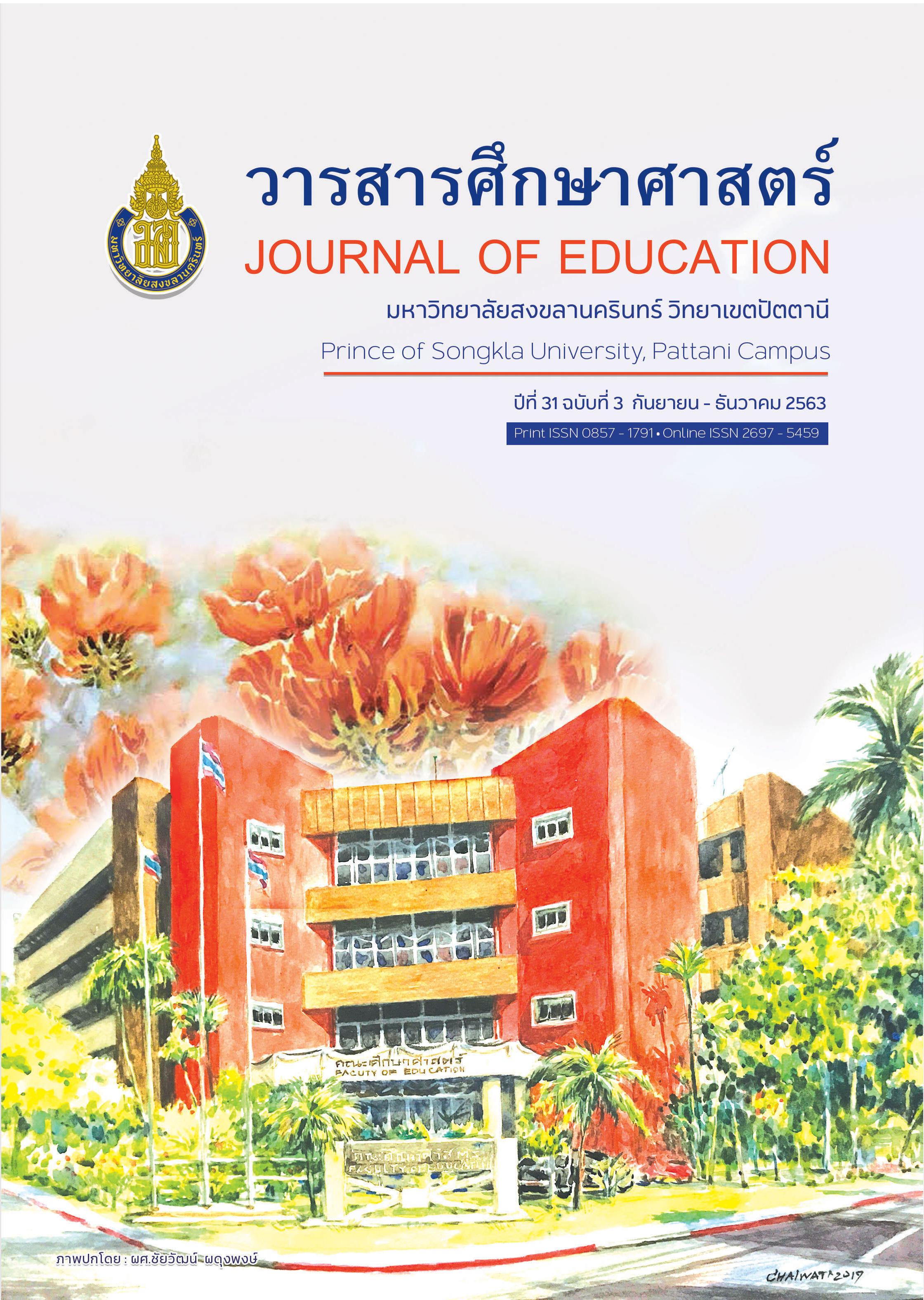การวิเคราะห์องค์ประกอบเชิงยืนยันความคิดสร้างสรรค์ทางวิทยาศาสตร์
Main Article Content
บทคัดย่อ
การวิจัยนี้มีวัตถุประสงค์เพื่อวิเคราะห์องค์ประกอบเชิงยืนยันความคิดสร้างสรรค์ทางวิทยาศาสตร์เก็บข้อมูลกับนักเรียนชั้นมัธยมศึกษาปีที่ 3 ในสังกัดสำนักงานเขตพื้นที่การศึกษามัธยมศึกษาเขต 15 จำนวน 500 คน โดยสุ่มตัวอย่างแบบแบ่งชั้น (Stratified Random Sampling) ประชากรที่ใช้ในการวิจัย ได้แก่ นักเรียนชั้นมัธยมศึกษาปีที่ 3 ในสังกัดสำนักงานเขตพื้นที่การศึกษามัธยมศึกษา เขต 15 จำนวน 46 โรงเรียน จำนวนนักเรียนทั้งหมด 28,095 คน (อ้างอิงจากข้อมูลสารสนเทศปีการศึกษา 2560 สพม.15) เครื่องมือวิจัยเป็นแบบวัดความคิดสร้างสรรค์ ความตรงมีค่าตั้งแต่ 0.60–1.00 ความยากมีค่าตั้งแต่ 0.33–0.49 อำนาจจำแนกมีค่าตั้งแต่ 0.22–0.48 และค่าความเที่ยง 0.98 การวิเคราะห์ความตรงเชิงโครงสร้างโดยใช้การวิเคราะห์องค์ประกอบเชิงยืนยัน โดยการทดสอบความสอดคล้องของโมเดลการวัดพิจารณาจากค่าสถิติ (Measurement model) ความคิดสร้างสรรค์ทางวิทยาศาสตร์ โดยพิจารณาจากค่าสถิติ วัดความกลมกลืน (Goodness of fit measures) ร่วมกับการวิเคราะห์ เศษเหลือหรือความคลาดเคลื่อนในการเทียบความกลมกลืน (Fitted residuals matrix) และการทดสอบความสอดคล้องของโมเดลการวัด โดยหาค่าดัชนีความเหมาะสมพอดีของโมเดล (Goodness of fit indices)
ผลการวิจัย พบว่า ความคิดสร้างสรรค์ทางวิทยาศาสตร์มี 3 องค์ประกอบ ได้แก่ ความคิดคล่อง (Fluency) ความคิดริเริ่ม (Originality) และความคิดยืดหยุ่น (Flexibility) โมเดลการวัดขององค์ประกอบความคิดสร้างสรรค์ทางวิทยาศาสตร์มีความเหมาะสมสอดคล้องกับข้อมูลเชิงประจักษ์โดยค่าดัชนีความสอดคล้องกลมกลืนประกอบด้วย = 8.87, df = 46, p-value = 0.35, RMSEA = 0.011, RMR = 0.011 , CFI = 1.00, GFI = 1.00 และน้ำหนักองค์ประกอบมีค่าตั้งแต่ 0.20 - 0.52
Article Details
เอกสารอ้างอิง
กระทรวงศึกษาธิการ. (2551). หลักสูตรแกนกลางการศึกษาขั้นพื้นฐาน พุทธศักราช 2551. กรุงเทพฯ: โรงพิมพ์ชุมนุมสหกรณ์การเกษตรแห่งประเทศไทย.
นงลักษณ์ วิรัชชัย. (2542). โมเดลลิสเรล: สถิติวิเคราะห์สำหรับการวิจัย. (พิมพ์ครั้งที่ 3). กรุงเทพฯ: จุฬาลงกรณ์มหาวิทยาลัย.
บุญรัตน์ จันทร. (2558). การพัฒนาความคิดสร้างสรรค์ทางวิทยาศาสตร์ของนักเรียนชั้นมัธยมศึกษาปีที่ 5 เรื่อง สมดุลกล โดยใช้การจัดการเรียนรู้แบบสืบเสาะหาความรู้ทางวิทยาศาสตร์. มหาวิทยาลัยเกษตรศาสตร์. สืบค้นจาก http://www.lib.ku.ac.th/KUCONF/2559/KC5308029.pdf
ปาริสา ผ่องพันธุ์งาม. (2550) ผลของการสอนแบบสืบเสาะหาความรู้ (Inquiry cycle) ที่มีต่อผลสัมฤทธิ์ทางการเรียนและความคิดสร้างสรรค์ทางวิทยาศาสตร์ของนักเรียนชั้นมัธยมศึกษาปีที่ 1. (วิทยานิพนธ์ศึกษาศาสตรมหาบัณฑิต), มหาวิทยาลัยขอนแก่น.
ประทุม อัตชู. (2547). ความคิดสร้างสรรค์ทางวิทยาศาสตร์. กรุงเทพฯ: มหาวิทยาลัยเกษตรศาสตร์.
ภาวิดา ตั้งกมลศรี. (2552). การพัฒนาชุดกิจกรรมฝึกเพื่อส่งเสริมความคิดสร้างสรรค์ทางวิทยาศาสตร์สำหรับนักเรียนชั้นประถมศึกษาปีที่ 6. (วิทยานิพนธ์ศึกษามหาบัณฑิต). มหาวิทยาลัยนเรศวร.
มัสยา แสนสม. (2552). การศึกษาผลสัมฤทธิ์ทางการเรียนวิทยาศาสตร์และความคิดสร้างสรรค์ทางวิทยาศาสตร์ของนักเรียนชั้นมัธยมศึกษาปีที่ 3 ที่ได้รับการจัดการเรียนรู้ด้วยชุดกิจกรรมพัฒนากระบวนการคิดอย่างสร้างสรรค์ทางวิทยาศาสตร์. (สารนิพนธ์การศึกษามหาบัณฑิต). มหาวิทยาลัยศรีนครินทรวิโรฒ.
วิจารณ์ พานิช. (2555). วิถีสร้างการเรียนรู้เพื่อศิษย์ในศตวรรษที่21. กรุงเทพฯ: มูลนิธิสดศรี-สฤษดิ์วงศ์.
วิทยา ทวีทรัพย์. (2532). การศึกษาความสัมพันธ์ระหว่างความคิดสร้างสรรค์ในการแก้ปัญหาเชิงวิทยาศาสตร์และผลสัมฤทธิ์ทางการเรียนวิชาวิทยาศาสตร์ของนักเรียนชั้นมัธยมศึกษาปีที่ 4 โรงเรียนอุดรพิทยานุกูล จังหวัดอุดรธานี. (วิทยานิพนธ์ศิลปศาสตรมหาบัณฑิต). มหาวิทยาลัยธรรมศาสตร์.
ศรายุทธ ชาญนคร ประทุม อัตชู และศศิเทพ ปิติพรเทพิน. (2557). การพัฒนาความคิดสร้างสรรค์ทางวิทยาศาสตร์ของนักเรียนชั้นมัธยมศึกษาปีที่ 1 เรื่อง บรรยากาศด้วยการจัดการเรียนรู้ตามแนวคิดวิทยาศาสตร์เทคโนโลยี วิศวกรรมศาสตร์และคณิตศาสตร์. สืบค้นจาก https://gsbooks.gs.kku.ac.th/58/the34th/pdf/HMO50.pdf
De Bono, Edward. (1982). Lateral Thinking: A Text book of Creativity. Harondswort. Penquin Book.
Torrence, E. P. (1992). A National Climate for Creativity and invention. Gifted Child Today. 5(1), 10-14.


